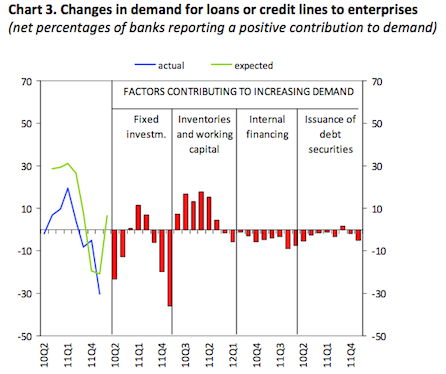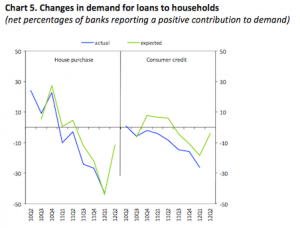Overnight the president of the European Central Bank, Mario Draghi, gave a speech to the Hearing at the Committee on Economic and Monetary Affairs of the European Parliament. The speech was not particularly out of line with what Mr Draghi usually says, such as:
Available indicators for the first quarter of 2012 broadly confirm a stabilisation in economic activity at a low level. Latest developments in survey data are mixed, highlighting prevailing uncertainty. Looking ahead, growth should be supported by foreign demand, the very low short-term interest rates as well as our non-standard measures. At the same time, downside risks relate in particular to a renewed intensification of tensions in euro area sovereign debt markets and their potential spillover to the real economy. Further increases in commodity prices may also hamper economic activity.
This is the same speech lead-in we have been hearing since Mario Draghi took over the helm of the ECB from Jean-Claude Trichet. Given recent PMI data much of this statements appears to be completely disconnected from the reality of what is happening in Europe, but this isn’t the first time I have noted Mr Draghi’s apparent delusion.
Mario Draghi went on to state that he thought Eurozone inflation would be stable because:
… the monetary analysis, in particular the subdued pace of underlying money growth, confirms the prospect of price developments remaining in line with price stability over the policy-relevant horizon. Money and credit data up to February point to a stabilisation of financial conditions. At the same time, the demand for credit remains weak in the light of still subdued economic activity and the continuing process of balance sheet adjustment in non-financial sectors.
I consider it of crucial importance that banks strengthen their resilience further, including by retaining earnings and by retaining bonus payments. The soundness of banks’ balance sheets will be a key factor in facilitating both an appropriate provision of credit to the economy and the normalisation of their funding channels.
Next came the 3 -year LTRO program:
The LTROs contributed to alleviate these very difficult funding conditions. Banks could satisfy their additional liquidity needs, which is reflected by a net liquidity injection of around €520 billion, taking into account the shifting of liquidity out of other operations. Moreover, banks have benefited from more certainty about their medium-term funding due to the longer maturity of the new operations.
I understand that you are particularly interested in the transmission of the LTROs to the real economy. This is indeed a crucial point: ensuring that the ECB’s monetary policy continues to be transmitted effectively to the real economy was a key motivation of the Governing Council decision. It is encouraging to observe that a very large number of small banks have participated in the two LTROs. Small banks are best placed to refinance the real economy, in particular small- and medium-sized firms which are the biggest generator of employment in the economy.
We are confident that central bank liquidity has come very close to the real economy. Of course, this does not mean that this will by itself boost lending to firms and households. First, the central bank cannot interfere with the banks’ use of the liquidity since that is their business decision. But we trust that they will use it to refinance the real economy because that is the role of a banking system. Second, the future evolution of credit growth will depend essentially on demand. In the current environment, this is likely to remain subdued. Thus, money and credit growth may stay weak for some time before the overall economic situation improves. The Bank Lending Survey, with some new information about financing conditions will be published at 10 am this morning.
So basically Mr Draghi is saying that one of the major reasons for implementing the LTRO was to ensure that monetary policy flowed into the real economy, but acknowledges that he really can’t control what the banks will do with ECB loans. He then suggests that the real problem is lack of demand stemming from economic weakness.
Next Mr Draghi talked about the monetary union’s failings:
Of course, divergences of economic developments are a normal feature within a monetary union. Such divergences can also be observed on the other side of the Atlantic. But they should not become of a persistent and structural nature.
Unfortunately, very large imbalances were allowed to accumulate over recent years in several European countries. These imbalances stemmed from different sources: insufficient fiscal discipline, financial excesses, failure to implement structural reforms especially, but not exclusively, in the labour and product markets and significant competitiveness losses. All of this necessitates urgent and resolute adjustment.
Clearly, it cannot be the responsibility of the ECB to address these imbalances. From the perspective of monetary policy, our primary objective is to maintain price stability in the euro area as a whole. For that purpose, the ECB continuously monitors all relevant information from the countries and various business sectors of the euro area. But the monetary policy stance of the ECB has to be focused on the entire euro area. It cannot address divergences among individual euro area countries.
That is the task of governments: they must undertake determined policy actions to address major weaknesses in the fiscal, financial and structural domains. We note that progress is being made in many countries. These measures need to be complemented by growth-enhancing structural reforms to facilitate entrepreneurial activities, the start-up of new firms and job creation. Here, governments should be more ambitious.
At the European level, there has been substantial progress towards reinforcing the economic governance framework. We have seen a strengthening of the fiscal rules of the Stability and Growth Pact and the introduction of the Fiscal Compact, about which we spoke in the Parliament last December. And we are implementing the new focus on correcting macroeconomic imbalances.
And here we see the contradictions.
Firstly, Mario Draghi states that it wouldn’t be right for the ECB to dictate to banks what they should be doing while his institution bails them out, yet feels free dictate policy to national governments.
Secondly, his reasoning for the failure of the LTRO to transmit monetary policy to the economy is that there is a lack of demand for credit, yet he is calling for further fiscal tightening on economies that are already shrinking.
Thirdly, he states that bank balance-sheets are the crucial component in stabilising the crisis, yet in an environment of subdued credit demand and struggling economies he expects banks to somehow increase their capital via lending to the private sector.
Many of these contradictions are highly visible in the Spanish banking system:
Mortgage lending by Spanish banks had their largest annual drop in more than six years in February – coming in at essentially half of what they were a year earlier. There are all kinds of reasons for this, not the least being that large numbers of Spaniards are out of work and house prices are still tumbling with at least one estimate being that they remain as much as 30 percent overvalued.
But given that Spanish lenders were among the biggest taker of the ECB’s largesse (officially known as LTROs, a name only a central banker’s mother could love) the lack of trickle down is less than bracing.
But it isn’t just Spain where this can be witnessed. As mentioned in the speech the ECB released the latest Eurozone banking survey overnight (available below). This is a document I have been waiting on for some time in order to get a better understanding of the effects of the LTRO program.
On the positive side the survey states that there has been a broad decline in credit tightening stemming from the banks access to liquidity and lower funding costs:
- According to the April 2012 BLS, the net tightening of banks’ credit standards on loans to non-financial corporations (NFCs) dropped markedly in the first quarter of 2012, to 9%, from 35% in the preceding quarter. This drop is much more pronounced than anticipated by survey participants at the time of the previous survey round (when it was expected to be 25%).
- Euro area banks also reported a significant decline in the net tightening of credit standards on loans to households for house purchase. The net percentage of banks reporting a tightening of credit standards on mortgage loans fell by more than expected in the previous survey, standing at 17% in the first quarter of 2012, down from 29% in last quarter of 2011.
- The net tightening of credit standards for consumer credit reported by euro area banks also declined more strongly than previously expected, to 5% in the first quarter of 2012, compared with 13% in the preceding quarter. A substantial reduction in pressures emerging from cost of funds and balance sheet constraints was reported also in this category.
On the negative side this has in no way effected the strong downwards trend in lending to the private sector:
- In the first quarter of 2012, the net demand for loans to NFCs dropped significantly (-30% in the first quarter of 2012, compared with -5% in the fourth quarter of 2011. By contrast, for the second quarter of 2012, banks expect a rise in demand for corporate loans. The fall in net demand for loans in the first quarter of 2012 was driven in particular by a further sharp drop in the financing needs of firms for fixed investment (-36% in the first quarter of 2012, compared with -20% in the fourth quarter of 2011).
- Euro area banks also reported a strong further contraction in the demand for housing loans in the first quarter of the year (-43% in net terms in the first quarter of 2012, from -27% in the preceding quarter. The decline was mainly on account of a deterioration in housing market prospects (-31%, compared with -27% in last quarter of 2011) and consumer confidence (-37%, compared with -34% in the previous quarter), as well as a decline in non-housing-related consumption.
- Net demand for consumer credit fell more strongly than expected in the first quarter of 2012, standing at – 26% according to euro area banks, compared with -16% in the previous survey round. This decline was mainly explained by the negative impact on loan demand from internal financing of households via savings (-13% in the first quarter of 2012, compared with -3% in the preceding quarter), lower household spending on durable goods and a decrease in consumer confidence (with both household spending on durable goods and consumer confidence falling to -28% in the first quarter 2012, from -20% in the last quarter of 2011).
As I have explained recently in the context of Spain, collapsing credit demand ultimately leads to a loss of banking capital, which is the exact opposite of what the LTRO program was set up to achieve. Interestingly, as the charts below show, banks seem to think that there will be a slowing of the fall in credit demand in the next quarter across all markets:


Given, as I said earlier this week, European fiscal policy is setting up Europe up for perpetual recession, I have no idea why the banks think this will occur. Overnight the UK joined Spain in technical recession. This lending data clearly suggests they won’t be the last.
Full banking survey report below.